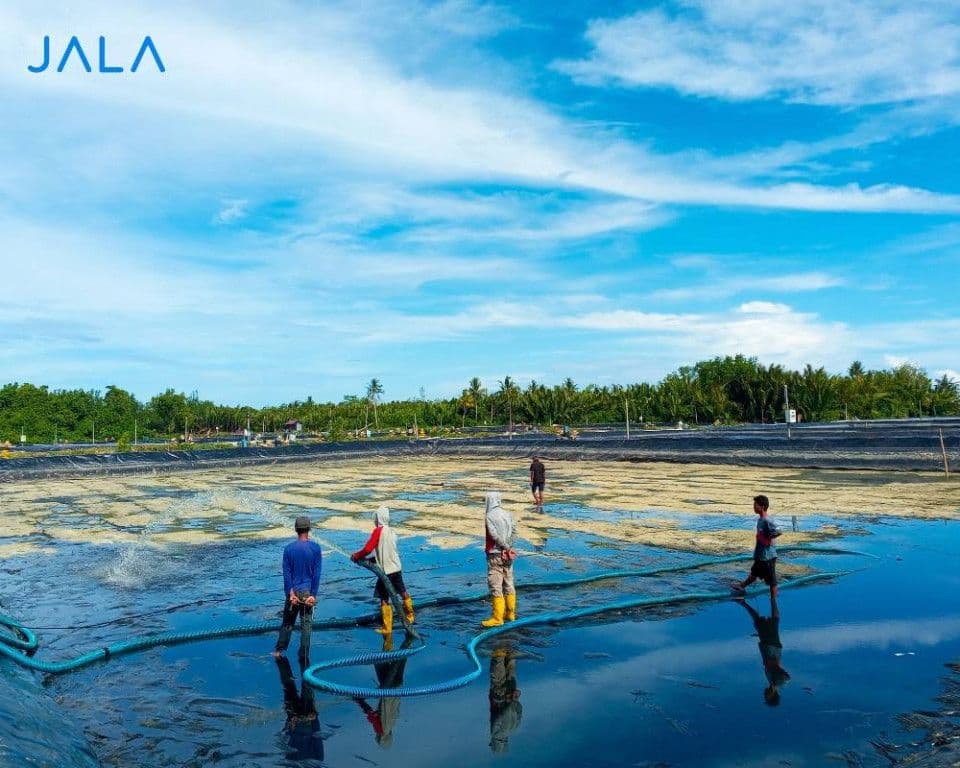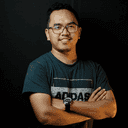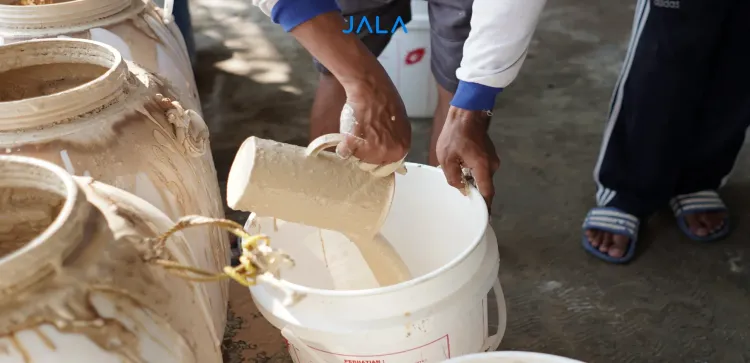
One of the measures of disease prevention in shrimp cultivation is through the application of biosecurity. Implementing biosecurity in shrimp cultivation has several benefits, such as minimizing the risk of infection, early detection of disease outbreak, suppressing loss due to disease outbreak, as well as preventing a wider spread.
The application of biosecurity in shrimp farms begins with keeping cultivation media and facilities clean. Both require cleaning and sterilization protocols.
Cleaning ponds and cultivation facilities
Cleaning is a treatment to release organisms that adhere to wall surfaces and the bottom of the pond, as well as cultivation equipment after the cultivation is complete or during preparation towards the next cultivation cycle. Equipment needs to be cleaned regularly and disinfected to deem it free from viruses and bacteria.
Cleaning is done with a plastic brush to clean moss, while cleaning adhering organisms requires a hard and blunt tool such as a bamboo strip.
Cleaning is best done in the day, when the plastic is completely dry, allowing easy removal of the adhering organisms. Every tool that has been cleaned is then dried under the sun. Drying can break the pathogenic cycle to prevent disease.
Sterilizing cultivation media
Sterilization is a process to remove all organisms in the cultivation media (pond or water) when it is being prepared. Sterilization greatly depends on the disinfectant and media condition. It can be done to at least two objects, which are the water and pond equipment.
Water sterilization is an important part of applying biosecurity as this step allows the removal of carriers to kill viruses and microbes. It is done in nurseries before stocking.
Diseases may also spread through farm equipment such as windmills, nets, water quality meters, and more. These equipment should be sterilized to prevent the spread of disease. It is even more crucial for ponds with a history of disease infection in previous cycles.
The procedure of disinfecting plastic pond layers or walls can be done with chlorine or TCCA, depending on the water source condition and pond area. For concrete layers or walls, HCl 50% can be used by pouring it on all pond surfaces and walls. To increase the effectiveness of the disinfectant used, apply it during noon, when the sun is at the highest point.
The application of biosecurity in every aspect of shrimp cultivation
Biosecurity needs to be applied in all cultivation phases, starting from land preparation, stocking, growing out, harvesting, and preparing for the next cycle. It also includes ensuring all facilities are free from pathogens. The purposes of biosecurity are:
- Preventing the entry of disease from outside the cultivation system from water, animals, humans, and equipment,
- Preventing the spread of disease from its source to other areas,
- Preventing the spread of disease from the pond to surrounding areas,
- Preventing disease infection from one cultivation cycle to another.
Applying cleanliness management in cultivation facilities is an important part of biosecurity. Make sure that any waste is recycled or disposed of in an area that will not contaminate the cultivation pond or surroundings. Moreover, workers or field technicians should have proper hygiene in doing every activity.
Biosecurity should be the priority of every shrimp cultivation. Applying it regularly requires awareness and consistency to minimize unwanted risks.
Besides implementing biosecurity, it is also important to track your cultivation conditions. JALA App is #HeretoHelp you with a lot of features, including recording and monitoring 40+ cultivation parameters, estimating cultivation performance, managing farm finances and inventory, and many more!
Let's start your cultivation journey with JALA App! Sign up now at app.jala.tech or download the app at Google Play Store or App Store.






